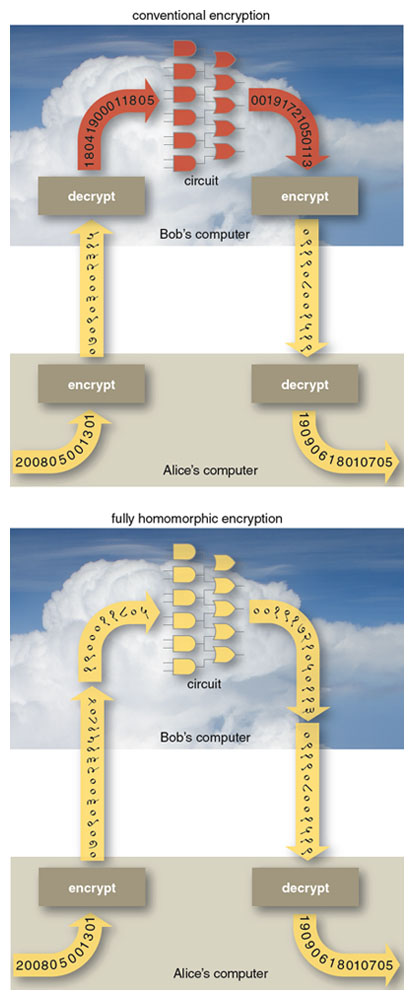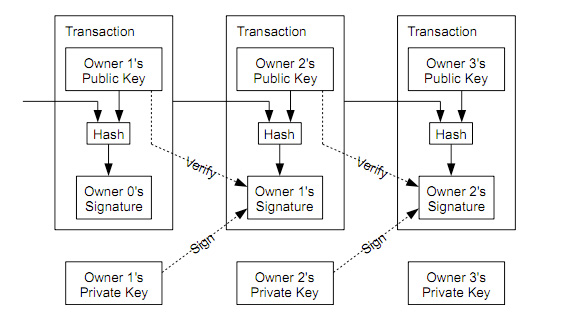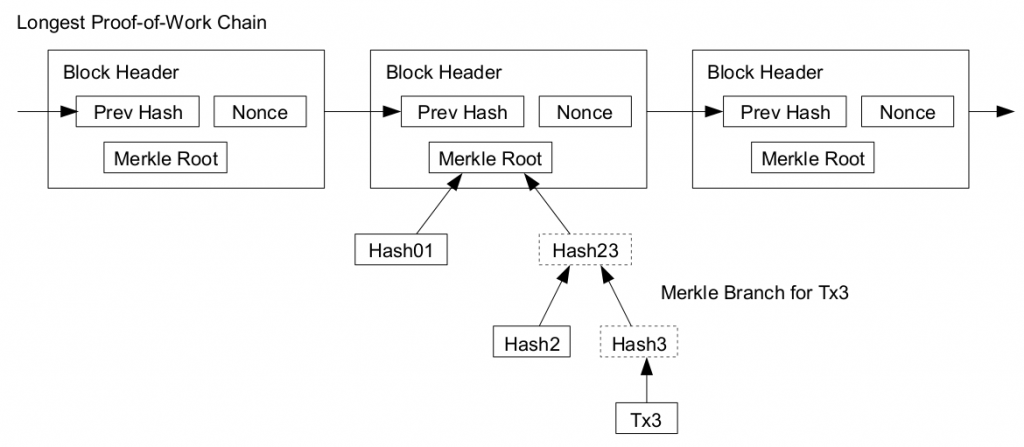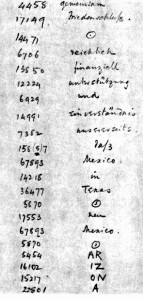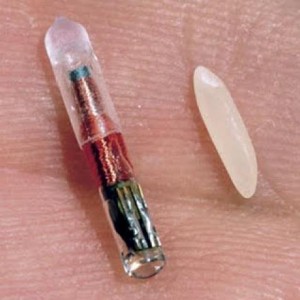Kris Shrishak
Homomorphic Encryption
Today, a lot of data is stored in the cloud. But what is a cloud? It is basically someone else’s computer with lot more storage space than regular laptops and desktop computers. Knowing this, some people encrypt the data before sending it to the cloud so that neither the owner of the cloud or a hacker who obtains access to the cloud can read the data. But what if the data that is encrypted is a file which you want to modify after uploading to the cloud?
One way would be to download the file from the cloud, decrypt it, modify it and then upload the modified file back to the cloud. Another way would be to decrypt the file online and modify it. But this would leave the file vulnerable. Thus this method can be ruled out. The first method is viable if the file is of the size that your computer can handle. What if you want to search for a keyword in a large number of files that you have encrypted and stored in the cloud? Assuming that these files are confidential, the only reason you are storing them in the cloud is due to lack of space on your computer, it is not viable to download the entire database and find the files with the keyword. So what will you do?
You can use homomorphic encryption. Homomorphic encryption is a form of encryption which allows processing of encrypted data and generate an encrypted result which, when decrypted, matches the result of operations performed on the plaintexts. It was first mentioned in 1978 by Rivest, Adleman and Dertouzo in their paper “On data banks and privacy homomorphisms”, but it took three decades for the first fully homomorphic encryption scheme to be proposed. In those thirty years, partially homomorphic schemes were proposed. RSA cryptosystem, that is widely used today, in its unpadded form is multiplicatively homomorphic, wherein the multiplication of two ciphertexts on decryption gives the product of plaintexts. ElGamal cryptosystem is another multiplicatively homomorphic scheme while Paillier cryptosystem is one of the additively homomorphic cryptosystems.
Image Source: http://www.americanscientist.org/issues/pub/2012/5/alice-and-bob-in-cipherspace/1
Needle in the haystack?
At the end of January, USENIX Enigma Conference was held in San Francisco. The program consisted of talks from the security community, both academic and industry. One of the talks that caught my attention is the talk by Nicholas Weaver titled The Golden Age of Surveillance, which focuses on the concepts behind bulk surveillance and its success.
In the talk Nicholas cleared two misconceptions about bulk surveillance. First, surveillance is not like needle in the haystack. Instead it is about the numerous needles and recognizing the one which is of interest. Second, it is not about connecting the dots. Collecting multitude of data gives so many dots that any constellation could be drawn.
Instead surveillance can be looked at as a two-step process. First to cast an internet-wide net, “drift nets”, and extract content derived metadata. One of the applications he mentions is PGP or Pretty Good Privacy. PGP which is used to send encrypted emails provides sufficient metadata though the data itself is hidden. Another example is .doc files which contain the author name. The author name can be matched to other documents that were captured in the net to derive more information.
The second step involves “pulling threads to get results”. For this he gives an example of how an anonymous user in an Internet Relay Chat (IRC) can be identified using Signal Intelligence and Computer Network Exploitation. Using internet wiretapping, the traffic is filtered and certain types of data such as videos is ignored. Then the source and destination IP address of the packets sent over the network is hashed in the load balancer and in the processing nodes, the packets are reassembled and the headers are parsed to derive the metadata. Finally he mentions how the information obtained through wiretapping can be used to inject packets (Quantum Insert) and take over the, once anonymous, user’s computer.
Articles on Quantum Insert can be found here and here. The talk by Nicholas can be viewed here.
Bitcoin and scalability
For the past few months, questions about the scalability of Bitcoin has been increasing and the developer community has attempted to come up with a solution. But the Bitcoin community is divided over the solutions and as mentioned here, it seems like an election where things are getting heated. As Bitcoin is based on consensus, a change cannot be made if a consensus is not reached.
Currently Bitcoin handles about 7 transactions per second while it has been claimed that the number is lower. Compare this to the 4000 transactions/second that VISA can handle, we see the gap in scalability. In order to scale Bitcoin, increasing the maximum block size (which is currently 1MB) is a necessity. More complex solutions, such as Segregated Witness proposed by Pieter Wuille at Scaling Bitcoin Conference in Hong Kong last December has found support in the community. Segregated Witness removes the signature from the transaction and stores it in a separate data structure, thus reducing the size of the transaction.
Gavin Anderson describes in his blog,
For example, the simplest possible one-input, one-output segregated witness transaction would be about 90 bytes of transaction data plus 80 or so bytes of signature– only those 90 bytes need to squeeze into the one megabyte block, instead of 170 bytes. More complicated multi-signature transactions save even more.
But why is Bitcoin scalability important? The Bitcoin network is congested and small increase in traffic leads to “dramatic changes in network conditions”. Transactions take minutes and sometimes hours to be executed. How many users find it acceptable to wait that long for their transactions to be executed?
Proof-Of-Work
The blocks in the block chain are created by nodes in the network, which called miners. A miner receives transactions from other nodes in the Bitcoin network. Every transaction is verified on arrival so that an attacker cannot maliciously transmit transactions to double spend a bitcoin. But the transactions are received in a non-deterministically which causes blocks to differ from miner to miner. Thus there needs to be a method to obtain consensus on the order of transactions among the nodes. Bitcoin uses a Proof-Of-Work (POW) system based on Hashcash.
As part of the POW system, a nonce is added to every block. The nonce is just a number but it is only accepted if the hash of the whole block begins with a certain number of zeros. Miners have to find the correct nonce for their block. The miner who finds the block receives a transaction fee as incentive to expend CPU time and electricity. It is possible that multiple miners find a valid nonce at approximately the same time and notify parts of the network of their newly found block. To solve this inconsistency, Bitcoin nodes save both branches and continue using the longest branch. At some point one branch will become predominant in the network as more nodes will dedicate computing power to extend this branch and the smaller branch is then abandoned.
The average time taken to find a block in a bitcoin network should be 10 minutes. Every two weeks, the number of zeros needed in the beginning of the hash of the transaction is adjusted to compensate for the fluctuating speed of the network to find a block. The difficulty of finding a block is directly proportional to the number of zeros.
One of the alternatives to POW is Proof-of-Stake. The video below explains it in comparison to POW.
Block chain
Block chain is the main technological innovation of Bitcoin. It was introduced by Satoshi Nakamoto as a timestamp server as part of the Bitcoin protocol. A block chain is a public ledger shared by all nodes participating in a system based on the Bitcoin protocol, that is, all nodes in the network have a copy of the entire block chain. A full copy of a block chain contains every transaction ever executed. Thus it is a proof of all the transactions on the network. But what is a transaction? A transaction is a transfer of Bitcoin value which is broadcast to the network and collected into blocks. A transaction typically references previous transaction by concatenating it with the public key of the new owner and hashing it. The current owner digitally signs this hash and sends it along with the public key of the new owner. A payee can verify the signatures to verify the chain of ownership.
Every block in the block chain contains a hash of the previous block such that a chain of blocks is created from the first block of the chain, also known as genesis block, to the current block. This way the blocks are arranged in chronological order. Due to the Proof-Of-Work, it is also computationally infeasible to modify a block as every block that follows must also be regenerated. These properties prevent double-spending in bitcoins. Double spending had been a threat to digital currencies before bitcoin. This is because unlike physical money, digital currency can be easily duplicated.
Considering all nodes in the network have a copy of the block chain, if every transaction is added to the block chain, then the size of the block chain will will sooner or later become to large. Instead just the merkle root of the merkle tree formed by the transactions to find a block can be used. To compute the merkle root, copies of each transaction is hashed, and the hashes are then paired and hashed, paired again and hashed again until a single hash remains, the merkle root of a merkle tree. The merkle root is stored in the block header. Transaction verification can be performed using Merkle Hash trees without checking the transaction itself.
Currency to Cryptocurrency
Bitcoin is a cryptocurrency, a digital currency which uses cryptography to create money and secure transactions. The transactions are processed in a decentralized manner such that the users do not need to trust any single party. The transactions are recorded in a blockchain which is a public ledger and can be cryptographically verified by anyone. This is a fascinating concept and one can find many resources to read about it, starting with Satoshi Nakamoto’s paper.
But before understanding bitcoins, there is one question that needs to be asked. What is money? And where does is come from? In the book Atlas Shrugged, Ayn Rand wrote,
Have you ever asked what is the root of money? Money is a tool of exchange, which can’t exist unless there are goods produced and men able to produce them. Money is the material shape of the principle that men who wish to deal with one another must deal by trade and give value for value. Money is not the tool of the moochers, who claim your product by tears, or of the looters, who take it from you by force. Money is made possible only by the men who produce.
It is a common notion that money is a commodity. But is it? Money can take multiple forms. Money can can take the form of commodity, paper or merely a value. The video below explains the transition from gold standard to fiat currency to bitcoin.
Below is a video [from 1:35 till 2:50] where a person with no prior experience with money finds it hard to grasp why the image in only a particular form (bank note) is of value and not otherwise. [I think the scene conveys the message even if one does not understand the dialogues]
https://youtu.be/x5Qb2b6nQFc?t=95
Finally a video on what gives money its value.
Zimmerman Telegram
On the interception of the Zimmerman telegram, the German diplomatic code 0075 was noticed by the British. Kahn mentions in (Kahn, 1967), Room 40 knew from its analyses that 0075 was one of a series of two-part codes that the German Foreign Office designated by two zeros and two digits, the two digits always showing an arithmetical difference of 2. Among the others, some of which Room 40 had solved, were 0097, 0086, which was used for German missions in South America, 0064, used between Berlin and Madrid and perhaps elsewhere, 0053, and 0042.” Initially only part of the long message was deciphered. But Zimmerman’s signature could be read. Code 0075 was a two-part code of 10,000 words and phrases numbered 0 to 9999 in mixed order. This was a gigantic monoalphabetic substitution cipher where instead of 26 alphabets, thousands of codes with low frequency were involved and whose characteristics were less defined than English alphabets. When a Code is intercepted, the initial identifications are first marked by pencil and placed in “pencil groups”. When confirmed by further traffic, they are placed in “ink groups”. But Room 40 did not have enough Code 0075 messages to decipher the Zimmerman telegram in total. Zimmerman telegram was partially deciphered but enough to obtain the core of the message. Though US entry into the war would have helped the Allies, there were enough arguments against informing the US. First, Room 40 was one of Britain’s darkest secrets. If a partially deciphered message is sent to the US, it would expose “Room 40”. Second, this would expose Britain’s habit of supervising telegrams of neutrals Third, this would lead to Germany using new codes instead of 26 alphabets, thousands of codes with low frequency were involved and whose characteristics were less defined than English alphabets.
The chief of Room 40, W.R. Hall, then devised a plan to obtain the telegram from Mexico. He thought that the German mission in Mexico may not have Code 0075 and might use an older code. He obtained a copy of the Zimmerman telegram as received in Mexico and realised that Code 13040, which was an older code, was used to encipher. This code was easier to decipher as Room 40 had intercepted many transmissions using the same code. A portion of the decrypted code is shown below. It can be observed that the word Arizona is not in the German codebook and has been split into phonetic syllables.
Hall showed the message to the secretary of the US embassy after few days. The secretary of the US embassy in Britain then sent the message to the US President. He himself did not know of the existence of Room 40 but wanted to keep his involvement secret. The authenticity of the telegram was initially doubted by the US government. But all doubts were eliminated by Zimmerman himself when he admitted to having sent the telegram (Boghardt, 2003). The telegram was published in newspapers and the citizens of US, who were initially against the war, pushed the government to participate in the war. The US involvement reinforced the Allied troops. “Room 40” was merged with British Intelligence unit MI1b to form Government Code and Cypher School which was later renamed as Government Communications Headquarters (GCQC).
References:
Kahn, David (1967), The Code Breakers: The Story of Secret Writing, Weidenfeld and Nicolson.
Boghardt, Thomas (2003), The Zimmermann Telegram: Diplomacy, Intelligence and The American Entry into World War I (PDF). Working Paper Series. Washington DC: The BMW Center for German and European Studies Edmund A. Walsh School of Foreign Service, Georgetown University. 6-04.
Room 40
In August 1914, British cable ship Telconia entered the North Sea and the men on-board cut the transatlantic cables and hence cut-off Germany from communicating through wired lines to the rest of the Western Europe and USA (Kahn, 1967). This forced Germany to use radio for all communication or use cables controlled by the Allies and hence allowed the Allies to intercept. In contrast, the British and French used wireless to communicate with ships at sea and not otherwise.
But Britain had no formal codebreaking organization even though intercepts were piling up. The Director of Naval Education, Alfred Ewing, put together a team of mostly volunteers from naval colleges to work on the intercepts. But they made no real progress. It was in September 1914 that the German cruiser Megdeburg was wrecked in Baltic and the Russians were able to obtain two cipher and signalling books from a drowning German officer. The Russians gave one of the books to the British. But Ewing’s team could not find any correlation between the four letter words in the books and the intercepts. Later it was found that the code had been superenciphered by monoalphabetic substitution. With the codebook in possession, deciphering became easy. Some codewords appeared more frequently, allowing for frequency analysis. Also the consonants appeared alternately with the vowels in the German codewords. The British acquired two more codebooks, one from a German-Australian steamer, Hobart, and another from the sinking German destroyer SMS S119 in the battle of Texel Island. With increasing number of intercepts and more men being recruited to decipher them, Ewing’s team moved to a large room Room 40, which lead to the organization informally being called Room 40.
Most intercepted messages reported the whereabouts of Allied ships. Though interesting, this information was not vital to the British. They recognized that the Germans also used short wave which the British could not intercept with the available infrastructure. So a station was set up to monitor shortwave signals and information about the movements of the High seas fleet was obtained. Even though it was no secret that the British had access to the codebook, the German’s continued to use the same until mid-1916. The book was massive and it could not be easily changed. But they did increase the frequency of changing the keys for monoalphabetic substitution. At the beginning of the war, the key was changed once in 3 months. In 1916, it was changed every midnight. But Room 40 had developed expertise and only needed few hours to find the new key every day.
Room 40 played an important role throughout the war. Winston Churchill wrote, “Without the cryptographers’ department there would have been no Battle of Jutland”. But the most important contribution of Room 40 was to decipher the Zimmerman telegram in 1917 which lead to America’s entry in the war. In this telegram, the German Foreign Minister Arthur Zimmerman offered Mexico the territories of Texas and Arizona if they join the war as a German ally. The message was sent from the US embassy in Berlin through Copenhagen and London to the German embassy in Washington. It was to be retransmitted to Mexico from there. The message read as follows:
We intend to begin on the first of February unrestricted submarine warfare. We shall endeavor in spite of this to keep the United States of America neutral. In the event of this not succeeding, we make Mexico a proposal of alliance on the following basis:Make war together, make peace together, generous financial support and an understanding on our part that Mexico is to reconquer the lost territory in Texas, New Mexico, and Arizona. The settlement in detail is left to you. You will inform the President [of Mexico] of the above most secretly as soon as the outbreak of war with the United States of America is certain and add the suggestion that he should, on his own initiative, invite Japan to immediate adherence and at the same time mediate between Japan and ourselves. Please call the President’s attention to the fact that the ruthless employment of our submarines now offers the prospect of compelling England in a few months to make peace.
Zimmerman
Reference:
Kahn, David (1967), The Code Breakers: The Story of Secret Writing, Weidenfeld and Nicolson
Implication of ‘Human Chipping’ on personal identity – Part 2: Are we artificial by nature?
Most human beings will consider implantation of RFID chips in the body as unnatural. But what is natural? One could say that what we are when we are born and the genetic information that we pass on to our children is natural. We are born naked, but we wear clothes to keep ourselves warm. Clothes are not natural to us. We are deprived of properties such as think skin or fur which many other animals have (Gehlen, 2003). We fulfill our requirements using technology.
It is natural that people contract diseases such as cancer and AIDS. Earthquakes and hurricanes are natural disasters. But these are not necessarily good for human beings. If it is possible to improve the situation through technological intervention, then why not? Like all changes in the society be it technological or not, the benefits are countered by the negatives. If the benefits outweigh the negatives then transhumanists would claim that there is no necessity for being skeptical about the technology (Bostrom, 2007).
Aristotle said that nature is grown while technology is made. Habermas claims that these categories de-differentiate when we interfere with nature (Habermas, 2003). He says humans should act morally as self-creating and autonomous beings. He claims that intervention leads to one category of ‘programmers’ and another of ‘programmed’. The ‘programmer treats the other person as object and has an attitude of domination while the ‘programmed’ will feel less free and lose autonomy as the attitude and behavior will be encoded. If Habermas’ categorization is applied to ‘Human Chipping’, the person or the organization who are implanting RFID chips on other human beings are the ‘programmers’ while the person with the implant is the ‘programmed’.
Let us consider the situation where newly born children are implanted with RFID chips. Initially these chips are used for identifying the infant in the hospital. This chip would be useful to monitor the health of the child throughout its life. Here there is no possibility of informed consent though. So the ‘programmed’ has no autonomy on choosing if it wants to be programmed or not. Humans are ‘by nature’ artificial and have no ‘natural origin’ and thus humans are a prosthetic being. Human evolution is the result of technical exteriorization of life. Humans are not autonomous but are ‘programmed’ by technology (Stiegler, 1998).
References:
Bostrom, N. (2007). In Defense of Posthuman Dignity. Bioethics, 206-214.
Gehlen, A. (2003). A Philosophical Anthropological perspective on technology. In R. C. Dusek, Philosophy of Technology: The Technological Condition: An Anthology (pp. 213-220). Blackwell Publishers.
Habermas, J. (2003). The Future of Human Nature. Polity Press.
Stiegler, B. (1998). Technics and Time: The fault of Epimetheus. Stanford University Press.
Implication of ‘Human Chipping’ on personal identity – Part 1: Are we Cyborgs?
The first RFID implant on a human being was performed in August of 1998 on the upper left arm of Professor Kevin Warwick in Reading, England (Gasson, ICT Implants, 2008). The implant was cylindrical in structure having a length of 22mm and diameter of 4mm. The doctor required to make a small hole, place the RFID chip and close the incision with couple of stitches. The implant allowed Professor Warwick to control lights, open doors and even receive welcome messages when he arrived. His location in the building could be tracked and monitored. This was only experimental and hence other possible applications of the technology were not considered by the scientists at that time.
One of the first commercial application of RFID chips was to replace ‘medic alert’ bracelets by VeriChip Corporation in 2004 (Gasson, ICT Implants, 2008). It was approved by the FDA in the United States of America for human use. It was used to relay medical details when linked to online medical database. For example, the details of the patient’s diabetes can be stored in the chips and because it is implanted, the patient cannot forget it or lose it. Later on the company also used these chips for infant protection and patient monitoring in hospitals. Subsequently these chips were used by nightclubs in Barcelona and Rotterdam to allow access to their VIP members. For example, at the Baja Beach Club in Rotterdam, these chips were implanted in their VIP members and were used for not only entry into the club but also for ordering drinks. For instance, if a member bought a drink, the chip could be read by an RFID reader and the amount can be deducted from the bank directly without the member getting hands on his/her wallet.
In these applications of ‘Human Chipping’, it can be seen that these RFID chips become a permanent part of the person. A person who has an RFID Chip in his arm for some time would become used to its functionality and would not think of it as an electronic component but instead as a part of his body (Gasson, Human implants from invasive to pervasive at TEDxGoodenoughCollege, 2012). How is the RFID implant any different from a person’s leg, hand or any other part of the body? If a person loses their legs in an accident, he will not be able to walk. If prosthetic legs are used he would be able to walk again. These prosthetic legs are made to function as legs such that the person is not able to differentiate it from his legs. They become a part of the person and not as an external component that he has worn. Similarly for the person whose diabetes is being monitored by the RFID implant, the chip becomes a part of the body. If the chip is removed, then the person’s existence would become difficult. His body will not function properly. If we are considering the chip as part of the body, aren’t we cyborgs?
One experiment done by researchers from Vrije University in Amsterdam amplifies the argument that we have become cyborgs. Their experiment involved placing a malicious computer code on a RFID tag, so that if the tag is read by the building system it would get infected by the virus (Rieback, Crispo, & Tanenbaum, 2006). Depending on the virus, it could disrupt the functioning of the building system or spread the virus to the tags used by others. Though this experiment sheds light on the security issues of the technology, we can look at its implications on personal identity. The spread of the computer virus using the implant is analogous to the spread of a communicable disease such as tuberculosis. The virus originates from the RFID tag implanted in a person and passes on to others. It is not possible to separate the RFID tag from the person and say that the virus originated from the tag but not from the person. Think of a situation in which this computer virus corrupts the functioning of every RFID chip that it infects. It might be fatal to a person whose insulin intake is dependent on the RFID chip. This could be a criminal offence but only if the chip is considered as part of the offender, which would make the offender a cyborg.
References:
Gasson, M. (2008). ICT Implants. The Future of Identity in the Information Society, 262, pp. 287-295. Retrieved from BBC: http://www.19.bbc.co.uk
Gasson, M. (2012). Human implants from invasive to pervasive at TEDxGoodenoughCollege. Retrieved from TedX: http://tedxtalks.ted.com/video/Human-implants-from-invasive-to
Rieback, M., Crispo, B., & Tanenbaum, A. (2006). Is your cat infected with a computer virus? IEEE International Conference on Pervasive Computing and Communication, (pp. 169-179).



